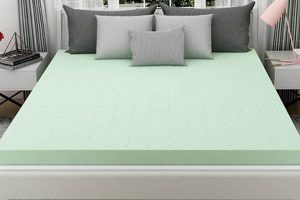The standardized measurement of the longer side of a double bed is generally 75 inches. This dimension is critical for ensuring comfortable accommodation, especially for adults, and facilitates the selection of appropriately sized bedding and bedroom furniture.
This particular dimension is a cornerstone in the mattress industry, influencing manufacturing, transportation, and sales processes. Its consistent application allows for efficient production and distribution, as well as simplified consumer choice when selecting bed frames, sheets, and other related accessories. Its widespread adoption simplifies the design and furnishing of bedrooms, promoting standardized comfort across diverse demographic segments.
Therefore, understanding this standard measurement is essential when considering space requirements for bedrooms, selecting new bedding, or evaluating the suitability of a bed for an individual’s height and sleeping preferences.
Tips Regarding the Standard Dimension of Double Beds
Understanding the practical implications of the 75-inch measurement can significantly aid in selecting the right mattress and optimizing bedroom layout.
Tip 1: Assess Room Dimensions: Prior to purchase, accurately measure the bedroom’s available space. Subtract the anticipated clearance around the bed to determine if the mattress dimensions are suitable without overcrowding the room.
Tip 2: Consider Sleeper Height: Individuals exceeding 5’10” may experience discomfort on a standard double bed. Evaluate the bed’s suitability relative to the primary occupant’s height to ensure sufficient legroom and overall sleep quality.
Tip 3: Evaluate Bed Frame Compatibility: Verify that the selected bed frame is explicitly designed to accommodate a double mattress’ dimensions. Mismatched dimensions can lead to instability, premature mattress wear, and compromised sleep support.
Tip 4: Choose Appropriate Bedding: Select sheets, blankets, and comforters that are specifically sized for double mattresses. Undersized bedding can result in uncovered areas and discomfort during sleep.
Tip 5: Consider Weight Distribution: This mattress is generally suitable for single sleepers or couples who do not require extensive personal space. Evaluate the mattress’ weight capacity and its ability to distribute weight evenly for optimal comfort and longevity.
Tip 6: Evaluate Foundation Support: Ensure the bed frame or foundation provides adequate support across the entire mattress surface. Sagging or uneven support can reduce mattress lifespan and negatively impact spinal alignment.
Adhering to these considerations will enhance the selection process, resulting in a more comfortable and ergonomically sound sleeping environment.
These suggestions provide a foundation for maximizing the benefits and addressing potential limitations associated with the standard double bed length.
1. Seventy-five inches
Seventy-five inches defines the standard longitudinal dimension of a full size mattress, acting as a foundational specification for the design, manufacture, and sale of these beds. This precise measurement directly dictates the amount of sleeping space available, impacting user comfort and overall sleep quality. For instance, a sleeper measuring over six feet in height (72 inches) might find this mattress length inadequate, leading to potential discomfort due to constrained legroom. Therefore, the 75-inch specification serves as a primary factor in determining whether a full size mattress meets the individual needs of a prospective buyer.
The adherence to this dimensional standard extends beyond individual comfort, influencing broader aspects of the bedding industry. Bed frame manufacturers design their products to precisely accommodate mattresses adhering to the 75-inch standard, ensuring a secure and stable fit. Bedding manufacturers produce sheets, comforters, and other accessories sized accordingly. This standardization fosters efficiency within the industry, simplifying product development, distribution, and consumer selection processes. A deviation from the 75-inch specification would cause widespread incompatibility issues throughout the bedding ecosystem.
In summary, the 75-inch dimension represents more than just a measurement; it’s a critical component of the full size mattress, influencing user comfort, manufacturing standards, and overall market dynamics. Disregarding this standard can lead to compromised sleep quality and compatibility challenges. As such, an understanding of this precise dimension is paramount for both consumers and industry professionals seeking to ensure optimal sleep experiences and efficient market operations.
2. Standard double size
The designation “standard double size” for mattresses directly correlates to and is defined by its dimensions, including the critical measurement of its length. This descriptor serves as a common identifier for mattresses adhering to a specific set of standardized measurements within the bedding industry.
- Dimensional Conformance
A mattress classified as “standard double size” adheres to prescribed length and width dimensions, typically 75 inches in length. Any deviation from these established measurements could disqualify a mattress from being accurately described as such. This adherence is crucial for ensuring compatibility with corresponding bed frames and bedding accessories.
- Market Standardization
The term “standard double size” provides a common point of reference within the marketplace, enabling consumers to easily identify and compare mattresses with similar dimensions. This standardization simplifies the purchasing process and reduces the likelihood of mismatched bedding or bed frame compatibility issues.
- Manufacturing Consistency
Manufacturers utilize the “standard double size” designation as a guideline for production, ensuring consistency in mattress dimensions across different brands and product lines. This consistency facilitates economies of scale and streamlines the manufacturing process.
- Consumer Expectation
Consumers relying on the “standard double size” label expect a mattress that conforms to the established dimensional norms. This expectation drives manufacturers to maintain adherence to these standards to uphold consumer trust and brand reputation.
In conclusion, the connection between “standard double size” and “full size mattress length” is intrinsic, as the designated length is a defining characteristic of what constitutes a mattress of that size. Any alteration to the established length dimension directly impacts the classification and marketability of the product.
3. Sleeping space optimization
The dimension directly influences a bedroom’s layout and usability. In smaller rooms, allocating space efficiently is paramount, and the 75-inch dimension of a standard mattress becomes a critical consideration. The length can be a decisive factor in determining whether other essential furniture pieces, such as dressers or desks, can comfortably fit within the room. Improper consideration can lead to overcrowding, restricting movement and diminishing the overall comfort of the space. Therefore, understanding and planning around the mattress length is vital for achieving a functional and aesthetically pleasing bedroom design.
This particular dimension affects multiple aspects of room functionality. For instance, allowing adequate clearance around the bed is essential for ease of access and movement. The mattress’ length must be factored into these clearance calculations to ensure unimpeded circulation within the bedroom. Moreover, the placement of the bed in relation to windows, doors, and other architectural elements is directly influenced by its length, affecting natural light exposure and ventilation. A well-optimized layout enhances the room’s usability and creates a more comfortable and inviting environment.
In conclusion, achieving effective space utilization necessitates a thorough understanding of this dimension. By carefully considering its impact on room layout, furniture placement, and circulation patterns, individuals can optimize the functionality and comfort of their bedrooms. A failure to account for this critical dimension can result in a cramped and inefficient living space, underscoring the importance of meticulous planning and dimensional awareness.
4. Bed frame compatibility
Proper bed frame compatibility is contingent upon the precise conformity of the mattress dimensions, particularly its length, to the internal measurements of the frame. A mismatch in these dimensions can lead to instability, reduced mattress lifespan, and compromised support.
- Dimensional Matching
The internal length of the bed frame must correspond directly with the stated mattress length to ensure a secure and stable fit. A frame that is too short will result in the mattress being compressed, potentially damaging its internal components. Conversely, a frame that is too long will leave unsupported gaps, causing the mattress to sag and wear unevenly.
- Support System Integration
The bed frame’s support structure, whether consisting of slats, a solid platform, or a box spring, is designed to distribute weight evenly across the mattress surface. An incompatible frame may provide inadequate support in certain areas, leading to localized sagging and discomfort. This can exacerbate issues for individuals with pre-existing back problems or sensitivities.
- Structural Integrity
When a mattress does not fit properly within a bed frame, the structural integrity of both components is compromised. The mattress may shift or slide during use, causing undue stress on the frame’s joints and potentially leading to premature failure. Similarly, the mattress itself may suffer from increased wear and tear due to the lack of proper support.
- Warranty Implications
Many mattress manufacturers stipulate specific requirements regarding the type of bed frame that must be used to support their products. Failure to use a compatible frame may void the mattress warranty, leaving the consumer responsible for any damage or defects that arise as a result of the improper support.
Therefore, meticulous attention to the mattress dimensions is paramount when selecting a bed frame. Deviation from the specified length can have significant consequences for both the comfort and longevity of the sleep system. Consumers should always verify the compatibility of their chosen mattress and bed frame to ensure optimal support, stability, and warranty coverage.
5. Body support needs
Optimal spinal alignment during sleep is intrinsically linked to the dimensions of the sleeping surface. The lengthwise measurement of a mattress influences the degree to which an individual can maintain a comfortable and supported posture, directly affecting the quality of rest and potentially mitigating musculoskeletal discomfort.
- Spinal Alignment and Posture
Inadequate mattress length forces a compromise in sleeping posture, potentially leading to spinal misalignment. For example, individuals exceeding 5’10” may experience forced flexion of the knees or an unnatural curvature of the spine to fit within a 75-inch space. Sustained misalignment can contribute to chronic back pain and discomfort.
- Pressure Point Relief
Proper distribution of body weight across the mattress is crucial for minimizing pressure points. A mattress that is too short may concentrate weight on the shoulders, hips, or knees, leading to localized discomfort and potentially disrupting sleep cycles. Sufficient length allows for a more even distribution of pressure, promoting better circulation and reducing the risk of pressure sores.
- Edge Support and Stability
The perimeter of a mattress plays a critical role in providing support when transitioning in and out of bed or when sleeping near the edge. Insufficient length can compromise edge support, increasing the risk of rolling off the mattress and potentially leading to injuries. A mattress that adequately accommodates the user’s length allows for secure and stable edge support, promoting confidence and safety.
- Accommodating Sleep Positions
Different sleep positions necessitate varying levels of support. Individuals who prefer to sleep on their side require sufficient length to accommodate the natural curvature of the spine and to prevent compression of the shoulders and hips. Similarly, back sleepers need adequate length to maintain proper spinal alignment without forcing the knees into an unnatural position. Selecting a mattress length appropriate for the preferred sleep position is essential for optimizing comfort and support.
The interplay between a mattress’s length and the sleeper’s body is a significant determinant of sleep quality. Addressing individual support requirements relative to mattress dimensions is fundamental to fostering restorative sleep and minimizing the risk of musculoskeletal issues. Careful consideration of these factors ensures a sleeping surface that caters to the unique needs of the user, promoting long-term health and well-being.
6. Room dimension planning
Room dimension planning is fundamentally intertwined with mattress length, representing a cause-and-effect relationship critical to residential space design. The longitudinal measurement of a full-size mattress dictates the minimum area required for functional placement within a bedroom. For instance, a room measuring 10 feet by 10 feet offers significantly more layout flexibility than a room measuring 8 feet by 10 feet, due in large part to the space consumed by the mattress’s 75-inch length. Therefore, understanding mattress dimensions is not merely a matter of aesthetics but a practical necessity for ensuring adequate space utilization and circulation within a living area.
The importance of room dimension planning as it relates to this measurement extends to furniture placement and accessibility. Overlooking the space occupied by the bed, specifically its length, can result in obstructed walkways, difficulty opening doors and drawers, and an overall sense of overcrowding. Consider a scenario where a bedroom is furnished without accounting for mattress length: The resulting layout may force individuals to navigate narrow passages between the bed and other furniture, creating an inconvenient and potentially hazardous environment. Careful planning, therefore, involves measuring the room, accounting for the mattress length, and strategically arranging furniture to maximize usability and minimize obstructions.
In conclusion, room dimension planning and the mattress length are inextricably linked. Accurate measurement and spatial awareness are essential for creating functional and aesthetically pleasing bedrooms. Failure to consider the mattress length during the planning stage can lead to significant spatial constraints, impacting the overall comfort and utility of the living space. Therefore, meticulous planning, grounded in a precise understanding of mattress dimensions, is a prerequisite for effective interior design and space optimization.
7. Mattress purchasing decisions
Mattress purchasing decisions are fundamentally influenced by the longitudinal measurement of the sleeping surface. The 75-inch dimension of a standard double mattress serves as a primary consideration, dictating its suitability for individual users and specific bedroom layouts. For example, an individual exceeding six feet in height will likely prioritize mattresses with greater longitudinal dimensions, rendering a standard double mattress unsuitable despite potentially lower costs or perceived space-saving benefits. Consequently, informed purchasing decisions necessitate an understanding of the relationship between individual needs, spatial constraints, and the inherent dimensional limitations of various mattress sizes.
The practical significance of this understanding extends beyond personal comfort. Hotels and other hospitality establishments, for instance, carefully consider mattress length when furnishing rooms to accommodate a diverse clientele. A hotel opting exclusively for standard double mattresses may face negative feedback from taller guests, potentially impacting customer satisfaction and repeat business. Likewise, individuals sharing a bed often prioritize larger mattresses, regardless of the standard length, to minimize sleep disturbance. The purchasing decision, therefore, becomes a complex equation balancing budgetary constraints with user expectations and practical considerations.
In conclusion, mattress purchasing decisions are inextricably linked to length as a critical attribute. Overlooking this factor can lead to compromised sleep quality, spatial inefficiencies, and unmet user expectations. The process involves a careful evaluation of individual height, sleeping habits, room dimensions, and budgetary limitations to determine the most appropriate mattress length, ensuring long-term comfort and satisfaction. Disregarding this critical aspect often results in suboptimal purchasing outcomes and potentially avoidable expenditures.
Frequently Asked Questions About Double Mattress Dimensions
The following provides answers to common inquiries regarding the length measurement of double mattresses.
Question 1: What precisely is the longitudinal measurement?
The dimension in question refers to the measurement of 75 inches defining the longer side of a standard double mattress. This dimension is a critical factor in assessing the bed’s suitability for individual sleepers and bedroom space.
Question 2: Why is adherence to the measurement important in the mattress industry?
Consistency in this measurement is critical for seamless manufacturing, transportation, and sales. It ensures compatibility with bed frames, bedding, and other accessories, streamlining consumer selection and minimizing incompatibility issues.
Question 3: How does a sleeper’s height relate to the suitability of a double mattress length?
Individuals exceeding 5’10” may experience discomfort due to limited legroom on a standard double mattress. Evaluating the mattress’s length in relation to the primary occupant’s height is crucial for optimizing sleep quality and comfort.
Question 4: What potential issues arise from mismatched bed frame and mattress dimensions?
Mismatched dimensions can lead to instability, premature mattress wear, and compromised sleep support. A bed frame specifically designed to accommodate the double mattress’ dimensions is essential for optimal functionality and longevity.
Question 5: How does this dimension affect room layout and furniture placement?
This dimension influences the arrangement of furniture and the efficient utilization of space within a bedroom. Accurate measurement and careful planning are necessary to prevent overcrowding and ensure ease of movement.
Question 6: Is there a universally accepted tolerance for this measurement, or are there variations?
While standardized, minor variations may occur during manufacturing. However, significant deviations from the 75-inch standard can indicate quality control issues or mislabeling. Consumers should verify dimensions prior to purchase.
These considerations provide a fundamental understanding of the double mattress length and its significance in selecting suitable bedding and optimizing sleep environments.
The next section will delve into alternative mattress sizes and their respective dimensions.
full size mattress length Conclusion
This exploration has elucidated the critical role of “full size mattress length” within the bedding industry and its direct impact on user experience. The standardized 75-inch measurement profoundly influences manufacturing processes, bed frame compatibility, and optimal sleeping comfort. Individual height, room dimensions, and support needs must be carefully considered in relation to this metric to ensure informed purchasing decisions and effective space utilization. The established dimension dictates overall comfort and space efficiency.
The future of bedding may involve increased customization and dimensional options, yet understanding established standards remains essential. Whether selecting a new mattress or designing a bedroom layout, awareness of this measurement is vital for maximizing comfort and satisfaction. Continued adherence to, and understanding of, these standardized dimensions will continue to serve both consumers and manufacturers in facilitating informed choices and efficient design.



![Best Full Bunk Bed Mattress [Comfort & Safety] Organic & Natural Mattress Buyer’s Guide: Non-Toxic Sleep Solutions Best Full Bunk Bed Mattress [Comfort & Safety] | Organic & Natural Mattress Buyer’s Guide: Non-Toxic Sleep Solutions](https://mattressworldpa.com/wp-content/uploads/2025/07/th-2815-300x200.jpg)



![Best Full Size Mattress Foundation [Guide] Organic & Natural Mattress Buyer’s Guide: Non-Toxic Sleep Solutions Best Full Size Mattress Foundation [Guide] | Organic & Natural Mattress Buyer’s Guide: Non-Toxic Sleep Solutions](https://mattressworldpa.com/wp-content/uploads/2025/07/th-2811-300x200.jpg)